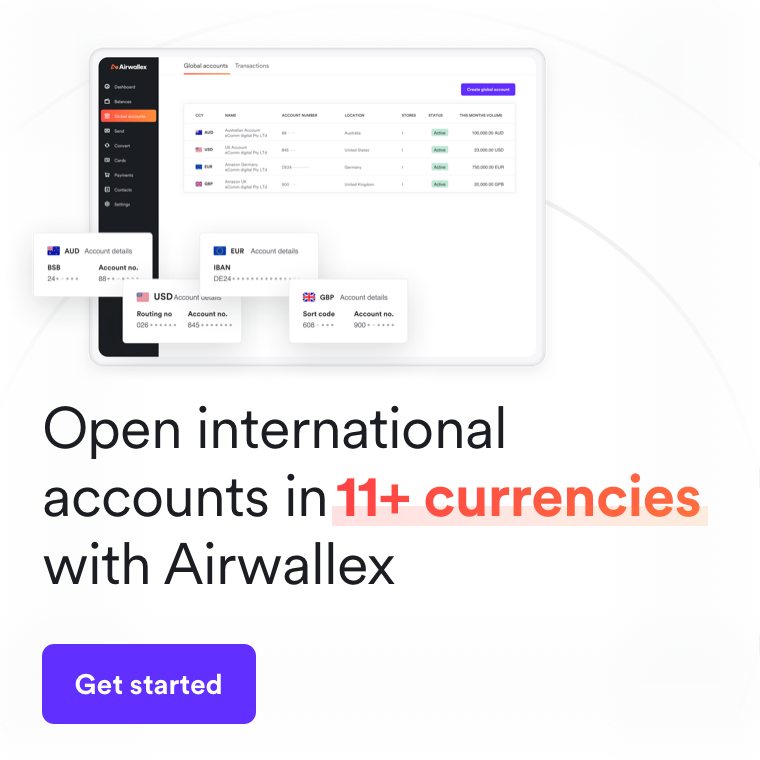What Australian Banks Charge for International Payments

If you're running an Australian business these days, you're bound to deal with international payments. However, the fees associated with these transfers can be a significant drain on your bottom line if you're not aware of how much you're truly being charged. These hidden costs, often tucked away in unfavourable exchange rates or unexpected intermediary fees, can quietly eat into your profits and impact your growth.
In this guide, we'll go into what Australian banks charge for international payments, providing you with a clear and comprehensive breakdown of the various fees involved. By understanding the exact costs associated with sending and receiving money across borders, you can make informed decisions for your business and safeguard your earnings.
Money transfer fees: What costs are involved with international money transfers?
There are a number of different fees involved when sending and receiving money internationally, including international transfer fees for sending and receiving money, intermediary bank fees, beneficiary bank fees, and FX margin.
International transfer fees - sending money
You'll typically pay a fee to transfer your money to an international bank account. Most banks have a fixed international transfer fee they charge you, however this cost is set by the bank itself, so will vary depending on who you choose. There may also be a difference in cost depending on the currency you’re sending, where you’re sending it, and whether or not you make the payment in AUD.
International transfer fees - receiving money
You may also be required to pay a fee to receive an international transfer. This fee is typically higher than a fee to send money. This fee gets deducted automatically from the sum you receive.
Intermediary bank fees
International money transfers often involve intermediary banks if the sending and receiving banks lack a direct relationship. This web of banks means each charges handling fees. The SWIFT network, commonly used for cross-border payments, charges a single flat fee per international transaction.
Beneficiary bank fees
If your bank and your recipient’s bank don’t have a direct financial relationship, then one or both of you will be required to pay a fee in order to process or receive the payment. This will be charged to the recipient when they receive the money, which means that the recipient’s payment will be eroded by bank fees, resulting in them receiving less than expected.
Foreign exchange (FX) margin
The foreign exchange, or FX, margin is the small amount that a bank adds on top of their interbank exchange rate when making your foreign currency exchange. It’s a mark-up usually ranging anywhere from 1–5%, but this ultimately enables the bank to make money off your foreign exchange.
Banks usually don’t disclose this mark-up. Here’s how to gauge the bank’s approximate FX margin:
Check the bank’s current FX rate on their website
Check this against an online FX converter like XE.com, which will give you the interbank exchange rate
Note the difference in FX rate. For example, it might be 0.7681 vs 0.7462
That gap between the two FX rates? That’s the margin the bank is charging on top of the actual exchange rate
So unless you’ve carefully compared the differences, you likely won’t notice a few percentage points here or there. You’ll only notice it once you complete the conversion, and you may end up paying more or receiving less than you expected.

What fees do Australian banks charge for an international money transfer?
The fees, rates, and other costs involved with sending or receiving money internationally will vary depending on the business bank account you have, the transfer method you use, the bank you’re with, and the exchange rate at the time of transfer.
Below you can see which banks charge what international transfer fees, and how much you can expect to be out of pocket.
For the foreign exchange rate, banks will typically mark up the rate by a particular margin. This markup is never explicitly stated on their websites anywhere, so the margins outlined below are based on research conducted by comparing the banks’ FX rate vs. the interbank FX rate, and concluding from there.
CommBank international money transfer fees
CommBank charges businesses $30 per international money transfer if you send in-branch, but this fee is waived if you use NetBank or the CommBank app. This does not include charges from the beneficiary’s bank or the FX rate which is 4–5% on top of the interbank FX rate. You will be charged $11 per transfer to receive a foreign currency transfer.
Westpac international money transfer fee
Westpac charges businesses $0 for foreign currency transfers made via the Westpac app, but international transfers made in-branch incur a $32 fee. The receiving bank can also charge fees and you will also be charged the FX margin rate, which is approximately 3–4% above the interbank rate. The receiving fee is $12 per incoming transfer.
NAB international money transfer fees
NAB charges businesses $0 for foreign currency transfers made via internet banking and $30 for transfers in a branch. You can be charged fees by the receiving bank, and NAB’s FX rate will also be applied, which is approximately 3–4% above the interbank rate. Incoming foreign currency transfers to your NAB Business Account will incur a minimum fee of $15.
Airwallex Global Account international transfer fees
An alternative to the banks, Airwallex helps you save up to 80% on your FX costs. The Global Account lets you hold multiple currencies and open local accounts in over 60 countries, which reduces your transfer costs. You can trade over 60 currencies at the interbank rate and payout to over 120 countries with local payment rails. For transfers above the interbank rate, you'll pay 0.5% for major currencies and 1% for other currencies.
How can you reduce bank fees for international money transfers?
You can reduce or avoid the fees you pay for international money transfers in a few ways. This includes by comparing the bank or financial platform you use to make your payments, using a calculator to see the full cost of the transfer to make an informed decision, and by considering non-banks and fintechs to save on your transfers.
Compare banks before making a transfer. Make sure you compare your options before making a transfer and research all fees involved. You should also check the best way to send and receive money, because it's more expensive to send with some banks when you go in branch or send payments in the same currency.
Use a comparison calculator. Do your homework, and shop around. Using a comparison calculator is a great way to compare the different fees and FX rates that banks are charging. For example, this Stripe fee calculator lets you compare Airwallex vs Stripe.
Consider bank alternatives. You can save a significant amount of money on international transfers by considering non-bank alternatives such as Airwallex, which often offer better exchange rates and lower fees compared to traditional banks.
Avoid bank transfer fees with an Airwallex Global Account
Going outside the big banks and opening a bank account in a foreign currency is the most direct way to send and receive money internationally. But, unfortunately, it’s also the most difficult.
An Airwallex Business Account makes it easy for you. You’re able to trade over 60 currencies at interbank rates and payout to over 200 countries. Using Airwallex for your business’ foreign currency transfers is a great way to save, with over 90% of transactions going through local payment rails (instead of SWIFT) helping you save up to 80% on FX fees.
You also receive access to Global Accounts which are created using local banking details for that currency. This works to reduce the fees that you and your recipient pay, and ultimately makes it easier for them to understand your banking process (as it works just like a local transfer).
You simply get limitless, same-day international money transfers. And you can start sending and receiving money as soon as your account is approved.

Frequently asked questions
Can I avoid bank fees for international money transfers?
Yes, you can avoid bank fees for international money transfers by comparing banks and fintech platforms such as Airwallex and Revolut, holding a multi-currency account and sending your transfer online.
How long do international money transfers take?
International money transfers can take between one and five days depending on a few factors, including where you're sending money from and where you're sending it to, the banks involved – including whether intermediary banks were involved – and the transfer method used.
Is it better to send an international money transfer online than in a bank branch?
Generally, yes. Many banks charge higher fees for sending an international money transfer in a branch than they do online. Currently, a few of the major banks – CommBank and Westpac, for example – don't charge for online international money transfers. Online platforms such as Airwallex can also offer competitive FX rates for money transfers.
Why did the amount I transferred not match what the recipient received?
The amount you send as an international transfer may differ from what’s received due to a few reasons, including fees deducted by intermediary banks in the SWIFT network or fluctuating currency rates. Make sure to check the recipient’s bank details because incorrect account information can also cause delays or the transfer being sent to the wrong account.
Sources:
https://www.commbank.com.au/business/international/international-payments/foreign-currency-accounts.html
https://www.westpac.com.au/business-banking/international-trade/international-payments/send-receive-money-overseas/
https://www.nab.com.au/important-information/business/banking-fees-charges#5-international-payments
Posted in:
Online payments

